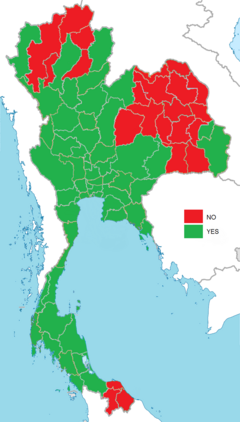Thai constitutional referendum, 2016
| Thai constitutional referendum, 2016 | |
|---|---|
| 1) Do you approve or disapprove of the draft constitution? 2) Do you approve that for contributing continuity of the country reform according to the national strategic plan, it should be stipulated in the Transitory Provisions of the Constitution of the Kingdom of Thailand that for the duration of 5 years from the first sitting of the National Assembly under this constitution; the joint sitting of the two chambers of the National Assembly shall convene to consider approving a person to be appointed as the Prime Minister? |
|

Provinces of Thailand colored according to referendum results (Charter)
|
|
| Location | Thailand |
| Date | 7 August 2016 |
| Draft constitution | |
| Election of the Prime Minister | |
A constitutional referendum was held in Thailand on 7 August 2016. The charter offered only semi-democracy and was seen to tighten military rule in Thailand. However, it was approved by 61% of voters with a 59% turnout. A second proposal for the next Prime Minister to be jointly elected by Senators and MPs was also approved. However, the opposition groups to the constitution were barred from formally campaigning against it by the military government, while the military government actively campaigned for its adoption.
The primary difference between the 2016 constitution and the 2007 document was that the Senate would become a fully appointed chamber rather than a partially elected one during the 5 year "transitional period" stipulated in the charter. This was seen as an effort by the National Council for Peace and Order (NCPO) to retain influence once it has left office, as it will have the right to appoint the 250 members. The Senate would also be granted veto power over the House of Representatives on amending the constitution, and a Prime Minister will be allowed to be appointed from outside either house.
The NCPO banned criticism of the draft constitution and prohibited monitoring of the referendum. Activists against the document were arrested, detained, and prosecuted in military courts, whilst voters who expressed their intention to vote against the draft were also arrested and prosecuted by the military regime.
350,000 canvassers were scheduled to be trained by the Constitutional Drafting Committee to campaign for the constitution, approximately four per village.
Turnout for the vote was at 59%. The vote was rejected in the pro-Thaksin Isan province and even more firmly in the three Muslim majority southern provinces. The ‘Yes’ camp accounted for 61.4 per cent of the voter turn-out, while the ‘No’ faction could garner only 38.6 per cent, with 94 per cent of the votes counted on the day after.
BBC reported that there are many cited reasons for the result, including repression on campaigning and criticizing the charter with only few people actually saw a copy. The drafters argued that it will address political corruption and help reform the country. Some trusted the military junta. Many voters were tired of endless political crisis and saw the charter as a way back to normality.
...
Wikipedia
